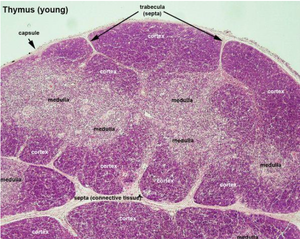Thymus - structure, position and syntopy, function
Introduction:
- Primary lymphoid organs are where lymphocytes first originate, including the thymus and bone marrow, while secondary lymphoid organs are where most lymphocyte get activated and proliferate for eg: in lymph nodes, spleen, tonsils, MALT , GALT etc.
- The thymus is fully functional at birth, remaining active until puberty when it gradually declines in size, cellularity, and T cell production - the size of the thymus decreases with age (it is replaced by adipose tissue)
Anatomically, the thymus is an asymmetric, flat organ primarily located in the superior mediastinum, situated posterior to the manubrium of the sternum. Encased in a connective tissue sheath, it forms incomplete lobules consisting of cortical and medullary components.
- The cortical portion, found peripherally within each follicle, contains lymphocytes supported by reticular epithelial cells
- The medullary portion (found centrally) houses fewer lymphocytes and more reticular epithelial cells, including Hassall's corpuscles.
Functionally, the thymus serves as the site for T-lymphocyte differentiation and the elimination of T cells reactive against self-antigens through a process known as thymic selection. Epithelial reticular cells produce paracrine factors crucial for T-lymphocyte development, selection, and migration.
Initially, lymphoblasts arriving from the bone marrow lack expression of CD4, CD8, or a TCR. They populate the cortex, undergo proliferation, recombine TCR genes, and eventually express CD4, CD8, and TCRs.
This process involves a two-stage selection mechanism:
- 1st step: Positive selection, occurs in the cortex of the thymus. Here, developing T cells (thymocytes) are exposed to self-antigens presented by thymic epithelial cells (TECs) on major histocompatibility complex (MHC) molecules. T cells expressing T cell receptors (TCRs) that can weakly bind to self-antigens presented on MHC molecules receive survival signals and progress to the next stage of development. Those T cells unable to recognize self-antigens undergo apoptosis (cell death) and are removed from the pool of developing T cells.
- 2nd step: Negative selection, takes place in the medulla of the thymus. Medullary thymic epithelial cells (mTECs) and dendritic cells present a wide range of self-antigens to the developing T cells. T cells with TCRs that strongly bind to self-antigens are eliminated through apoptosis to prevent the development of potentially harmful auto-reactive T cells. T cells that survive negative selection and pass this stage are released into the bloodstream as mature, self-tolerant T cells ready to perform their functions in the immune system.
Regarding its vasculature,
- arterial supply: anterior intercostal arteries & small branches from the superior thyroid, inferior thyroid and internal thoracic arteries
- venous drainage: into left brachiocephalic vein and the right internal thoracic vein
References:
- Memorix
- Junqueira's Basic Histology: Text and Atlas



